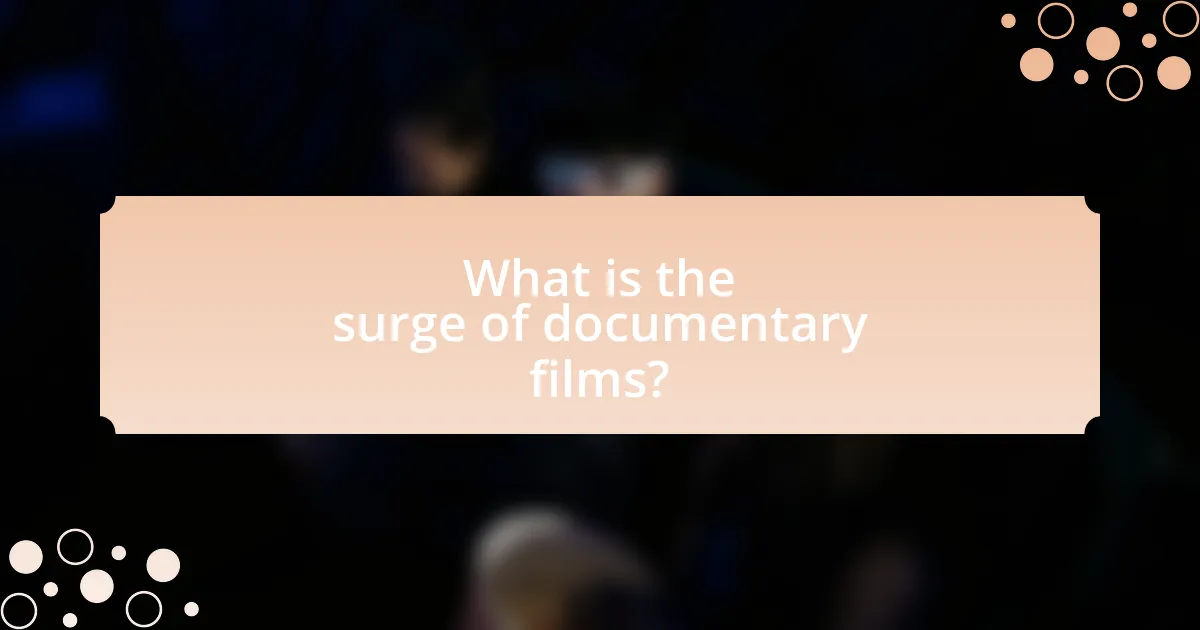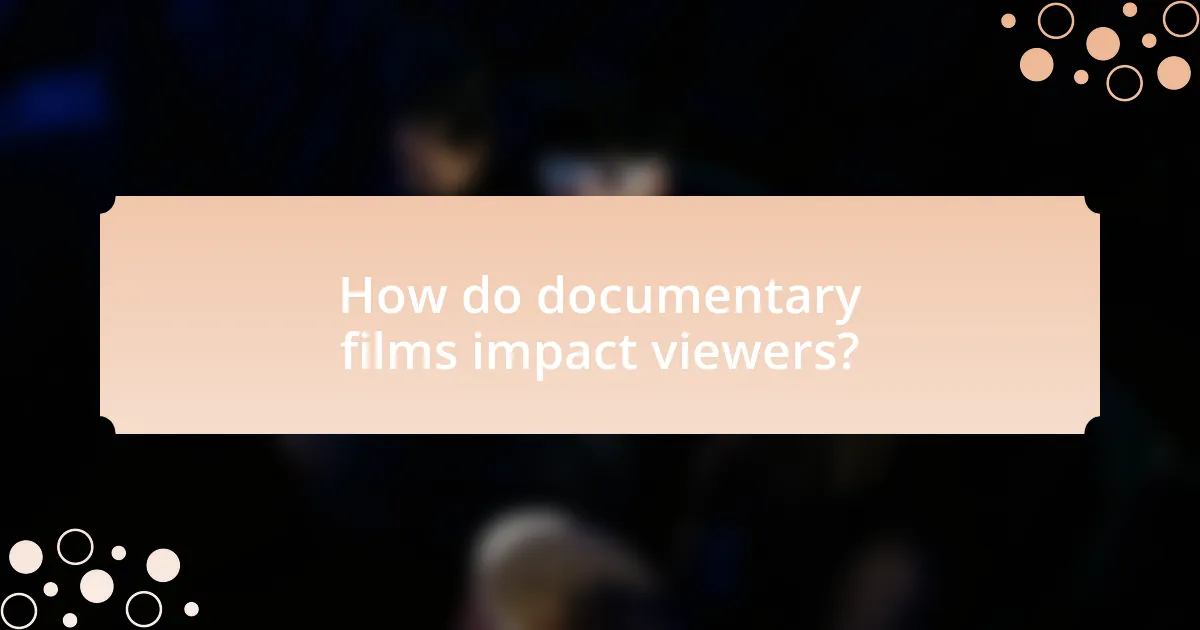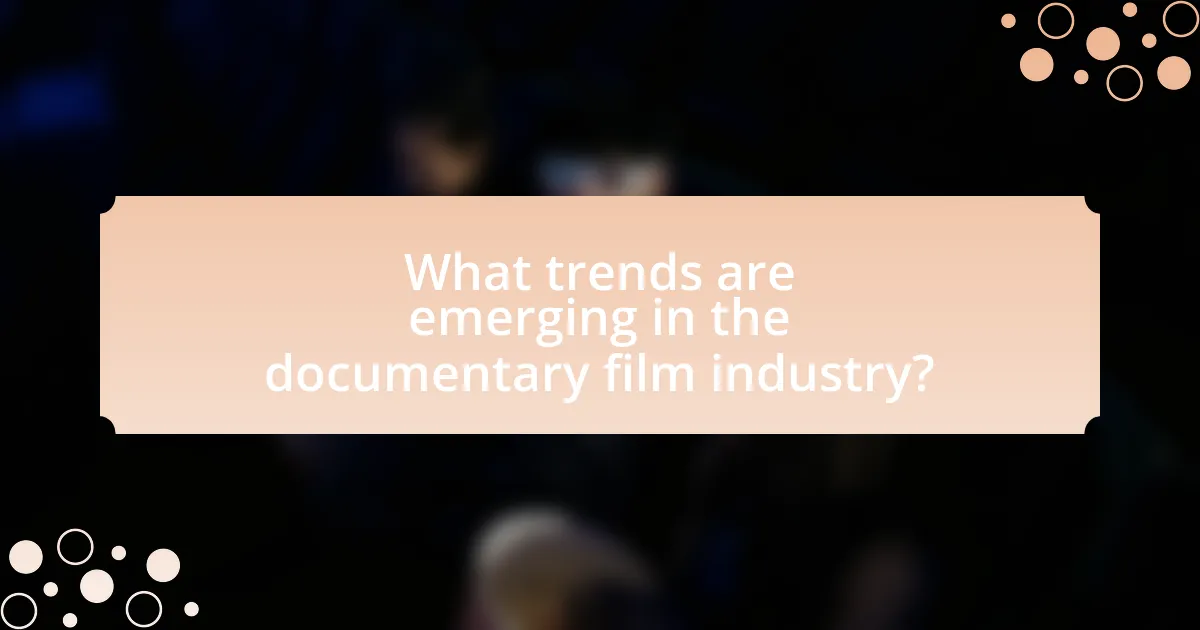The article examines the surge of documentary films, highlighting the significant increase in their production and viewership over the past decade. Key factors contributing to this trend include the accessibility of streaming platforms like Netflix and Hulu, which have expanded documentary offerings and invested in original content, resulting in a notable rise in audience engagement. The article also explores the growing public interest in social issues and the demand for authentic storytelling, emphasizing how documentaries educate, inform, and inspire action among viewers. Additionally, it discusses emerging trends in the documentary film industry, including innovative storytelling techniques and the role of social media in fostering audience engagement.

What is the surge of documentary films?
The surge of documentary films refers to the significant increase in their production and viewership, particularly in the last decade. This rise can be attributed to several factors, including the accessibility of streaming platforms, which have made diverse documentary content readily available to global audiences. For instance, platforms like Netflix and Hulu have invested heavily in original documentary programming, leading to a reported 50% increase in documentary viewership from 2015 to 2020. Additionally, the growing public interest in social issues, environmental concerns, and personal stories has driven audiences to seek out non-fiction narratives that resonate with contemporary societal themes.
Why are documentary films gaining popularity among audiences?
Documentary films are gaining popularity among audiences due to their ability to provide authentic storytelling and real-life insights. This rise in interest can be attributed to the increasing demand for factual content that resonates with viewers’ desire for truth and transparency, especially in an era marked by misinformation. According to a 2021 report by the Pew Research Center, 73% of Americans believe that documentaries help them understand complex issues better, highlighting their educational value. Additionally, platforms like Netflix and Hulu have significantly expanded their documentary offerings, making them more accessible and appealing to a broader audience.
What factors contribute to the increasing interest in non-fiction storytelling?
The increasing interest in non-fiction storytelling is primarily driven by the demand for authenticity and relatability in media. Audiences are increasingly seeking content that reflects real-life experiences and truths, which non-fiction storytelling provides. This trend is supported by the rise of social media platforms, where personal narratives and real stories gain traction, fostering a culture that values genuine connections over fictionalized accounts. Additionally, the accessibility of information through digital platforms allows viewers to engage with diverse perspectives and stories, further fueling interest in non-fiction formats. Research indicates that 70% of viewers prefer documentaries that explore real events and issues, highlighting a significant shift towards valuing factual storytelling in contemporary media consumption.
How has the accessibility of documentary films changed in recent years?
The accessibility of documentary films has significantly increased in recent years due to the rise of streaming platforms and digital distribution. Services like Netflix, Amazon Prime, and Hulu have expanded their documentary offerings, making a diverse range of films available to global audiences. According to a report by the International Documentary Association, the number of documentary films available on streaming platforms has grown by over 50% since 2018, allowing viewers to access content that was previously limited to film festivals or niche channels. This shift has democratized access to documentary films, enabling more people to engage with non-fiction storytelling.
What role do streaming platforms play in the rise of documentary films?
Streaming platforms significantly contribute to the rise of documentary films by providing accessible distribution channels and diverse content libraries. These platforms, such as Netflix and Amazon Prime, have invested heavily in original documentary productions, increasing visibility and audience engagement. For instance, Netflix reported that its documentary viewership grew by 50% in 2020, indicating a substantial demand for non-fiction content. Additionally, the algorithms used by these platforms promote documentaries based on viewer preferences, further enhancing their reach and popularity. This combination of investment, accessibility, and targeted promotion has transformed the documentary landscape, making it a prominent genre in contemporary media consumption.
How have platforms like Netflix and Hulu influenced documentary production?
Platforms like Netflix and Hulu have significantly influenced documentary production by providing increased funding and broader distribution channels. These streaming services have invested heavily in original documentary content, with Netflix alone spending over $250 million on documentaries in 2020, which has led to a surge in high-quality productions. Additionally, the accessibility of these platforms allows documentaries to reach global audiences, enhancing visibility and engagement. This shift has encouraged filmmakers to explore diverse and niche topics, as evidenced by the success of documentaries like “13th” and “Tiger King,” which gained widespread attention and sparked discussions on social issues.
What types of documentaries are most popular on streaming services?
True crime documentaries are the most popular type on streaming services, driven by their gripping narratives and real-life intrigue. According to a 2021 report by the streaming analytics firm Parrot Analytics, true crime titles consistently rank among the top-viewed genres, with series like “Making a Murderer” and “The Keepers” attracting millions of viewers. Additionally, nature and wildlife documentaries, such as “Our Planet,” have gained significant traction, appealing to audiences interested in environmental issues and stunning visuals. These trends indicate a strong preference for engaging, real-world stories that resonate with viewers on streaming platforms.

How do documentary films impact viewers?
Documentary films significantly impact viewers by shaping their perceptions, increasing awareness, and influencing attitudes toward various social, political, and environmental issues. Research indicates that documentaries can evoke emotional responses, leading to greater empathy and understanding of complex topics. For instance, a study published in the journal “Media Psychology” found that viewers of documentaries about social justice issues reported increased motivation to engage in activism after viewing. This demonstrates that documentary films not only inform but also inspire action, making them a powerful medium for social change.
What emotional responses do documentary films evoke in audiences?
Documentary films evoke a range of emotional responses in audiences, including empathy, sadness, anger, and inspiration. These films often present real-life stories and issues, allowing viewers to connect deeply with the subjects portrayed. For instance, documentaries like “13th” by Ava DuVernay elicit anger and sadness by highlighting systemic racism and mass incarceration in the United States. Research indicates that emotional engagement in documentaries can lead to increased awareness and motivation for social change, as viewers are moved by the narratives and experiences shared. This emotional resonance is a key factor in why audiences are increasingly drawn to non-fiction storytelling.
How do personal stories in documentaries resonate with viewers?
Personal stories in documentaries resonate with viewers by creating emotional connections that foster empathy and understanding. These narratives often present relatable experiences, allowing audiences to see reflections of their own lives or the lives of people they know. Research indicates that emotional engagement significantly enhances viewer retention and impact; for instance, a study published in the journal “Media Psychology” found that personal stories increase viewer identification with subjects, leading to a deeper emotional response. This connection not only captivates viewers but also encourages them to reflect on broader societal issues, making the documentary’s message more powerful and memorable.
What is the significance of factual storytelling in shaping public opinion?
Factual storytelling is significant in shaping public opinion because it provides credible information that influences perceptions and beliefs. By presenting verified facts and real-life narratives, factual storytelling fosters trust and engagement among audiences. Research indicates that documentaries, which often utilize factual storytelling, can effectively sway public attitudes on social issues; for instance, a study published in the Journal of Communication found that viewers of social issue documentaries reported increased awareness and changed opinions regarding those issues. This demonstrates that factual storytelling not only informs but also has the power to mobilize public sentiment and drive social change.
How do documentaries educate and inform audiences?
Documentaries educate and inform audiences by presenting factual information and real-life narratives that enhance understanding of complex subjects. They utilize visual storytelling, expert interviews, and primary sources to convey knowledge, making abstract concepts more accessible. For instance, the documentary “13th” by Ava DuVernay explores the history of racial inequality in the United States, using historical footage and statistics to illustrate systemic racism. This method not only informs viewers but also encourages critical thinking and discussion about societal issues.
What topics are most commonly explored in contemporary documentaries?
Contemporary documentaries commonly explore topics such as social justice, environmental issues, health and wellness, politics, and personal narratives. These subjects resonate with audiences due to their relevance and the urgent nature of the issues presented. For instance, documentaries like “13th” address systemic racism and mass incarceration, while “Our Planet” highlights climate change and biodiversity loss. The focus on these themes reflects a growing public interest in understanding complex societal challenges and personal stories that evoke empathy and awareness.
How do documentaries contribute to social awareness and activism?
Documentaries contribute to social awareness and activism by presenting factual narratives that highlight pressing social issues, thereby educating viewers and inspiring action. For instance, films like “An Inconvenient Truth” have raised awareness about climate change, leading to increased public discourse and policy changes. Additionally, documentaries often provide a platform for marginalized voices, fostering empathy and understanding among audiences, which can mobilize community engagement and advocacy efforts. Research indicates that exposure to documentary content can significantly influence viewers’ perceptions and willingness to participate in social movements, as evidenced by the rise in activism following the release of impactful films.

What trends are emerging in the documentary film industry?
Emerging trends in the documentary film industry include increased accessibility through streaming platforms, a rise in interactive and immersive storytelling techniques, and a focus on social justice themes. Streaming services like Netflix and Hulu have expanded the audience reach for documentaries, with Netflix reporting that 25% of its subscribers watch documentaries regularly. Interactive documentaries, utilizing virtual reality and web-based formats, engage viewers in new ways, enhancing the storytelling experience. Additionally, documentaries addressing social issues, such as climate change and racial inequality, have gained prominence, reflecting a growing audience demand for content that fosters awareness and advocacy.
What innovative techniques are filmmakers using in documentaries today?
Filmmakers today are utilizing innovative techniques such as immersive storytelling, interactive documentaries, and advanced technology like virtual reality (VR) and augmented reality (AR). Immersive storytelling engages audiences by placing them in the center of the narrative, often using first-person perspectives or participatory elements that enhance emotional connection. Interactive documentaries allow viewers to choose their own paths through the content, creating a personalized experience that increases engagement. The use of VR and AR technologies provides a more visceral experience, enabling audiences to explore environments and narratives in ways that traditional formats cannot. These techniques are supported by the increasing accessibility of high-quality production tools and platforms, which have democratized documentary filmmaking and expanded its reach.
How is technology changing the way documentaries are produced and consumed?
Technology is transforming documentary production and consumption by enabling greater accessibility and innovative storytelling techniques. Advances in digital cameras and editing software allow filmmakers to produce high-quality content at lower costs, making it easier for independent creators to enter the market. Streaming platforms like Netflix and Amazon Prime Video have revolutionized distribution, allowing audiences to access a diverse range of documentaries from anywhere, significantly increasing viewership. According to a report by the International Documentary Association, the number of documentary films produced has surged, reflecting this shift in production capabilities and consumption patterns.
What new genres or styles are being developed within documentary filmmaking?
New genres and styles being developed within documentary filmmaking include immersive documentaries, hybrid formats that blend fiction and non-fiction, and interactive documentaries. Immersive documentaries utilize virtual reality and augmented reality technologies to create engaging experiences for viewers, allowing them to explore narratives in a more participatory manner. Hybrid formats, such as docudramas, combine factual storytelling with dramatized elements, appealing to audiences seeking both entertainment and information. Interactive documentaries enable viewers to influence the narrative through choices, enhancing engagement and personal connection to the subject matter. These developments reflect the evolving landscape of documentary filmmaking, driven by technological advancements and changing audience preferences.
How are audiences engaging with documentary films beyond viewing?
Audiences are engaging with documentary films beyond viewing by participating in discussions, attending screenings, and sharing content on social media platforms. These interactions enhance the viewing experience and foster community engagement. For instance, post-screening Q&A sessions with filmmakers or subject matter experts allow audiences to delve deeper into the film’s themes and messages. Additionally, social media platforms enable viewers to share their thoughts, create discussions, and promote awareness about the documentary’s subject matter, thereby expanding its reach and impact. According to a study by the Pew Research Center, 72% of social media users engage with documentary content by sharing or discussing it online, illustrating the significant role of digital platforms in audience engagement.
What role do social media and online communities play in documentary discussions?
Social media and online communities significantly enhance documentary discussions by providing platforms for audience engagement and interaction. These digital spaces allow viewers to share opinions, analyze content, and connect with filmmakers and experts, fostering a collaborative environment for dialogue. For instance, platforms like Twitter and Facebook enable users to participate in real-time discussions during or after screenings, amplifying diverse perspectives and insights. Research indicates that 70% of documentary viewers engage in online discussions about films, highlighting the importance of these platforms in shaping public discourse around non-fiction narratives.
How can viewers participate in the documentary filmmaking process?
Viewers can participate in the documentary filmmaking process by engaging in crowdfunding campaigns, providing feedback during screenings, and sharing their personal stories or experiences related to the documentary’s subject matter. Crowdfunding platforms like Kickstarter and Indiegogo allow viewers to financially support projects they are passionate about, directly influencing the production. Feedback from audiences during test screenings can shape the final edit, ensuring the film resonates with its intended audience. Additionally, viewers can contribute their narratives, which may be incorporated into the documentary, enriching its content and perspective. This participatory approach has been increasingly recognized in the documentary field, as evidenced by projects like “The Act of Killing,” where audience engagement played a crucial role in shaping the narrative.
What are some best practices for creating impactful documentary films?
To create impactful documentary films, filmmakers should focus on thorough research, compelling storytelling, and authentic representation. Thorough research ensures that the subject matter is accurate and well-informed, which builds credibility. Compelling storytelling engages the audience emotionally, making the content relatable and memorable. Authentic representation of subjects fosters trust and connection with viewers, as seen in successful documentaries like “13th,” which effectively combines these elements to address complex social issues. These best practices contribute to the overall effectiveness and resonance of documentary films with audiences.
How can filmmakers effectively tell a compelling story through non-fiction?
Filmmakers can effectively tell a compelling story through non-fiction by focusing on authentic narratives that resonate emotionally with audiences. This involves selecting relatable subjects, utilizing strong character development, and employing narrative techniques such as conflict and resolution to engage viewers. For instance, the documentary “13th” by Ava DuVernay effectively combines historical context with personal stories to highlight systemic racism, making complex issues accessible and emotionally impactful. This approach not only informs but also fosters a connection with the audience, demonstrating the power of storytelling in non-fiction.
What ethical considerations should be taken into account in documentary filmmaking?
Ethical considerations in documentary filmmaking include informed consent, representation, and the potential impact on subjects and audiences. Filmmakers must ensure that individuals featured in their documentaries understand how their stories will be used and portrayed, which is crucial for maintaining trust and integrity. Additionally, filmmakers should strive for accurate and fair representation of subjects to avoid perpetuating stereotypes or misinformation. The potential consequences of the documentary on both the subjects and the audience must also be considered, as documentaries can influence public perception and societal norms. These ethical principles are essential for responsible storytelling and maintaining credibility in the documentary genre.